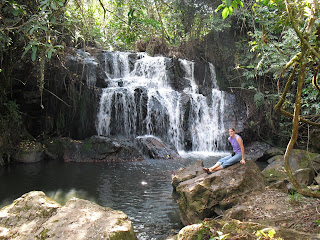For the past six weeks I have been studying Kiswahili in the town of Morogoro Lake Victoria , it is not lacking in natural splendor. Morogoro is located at the base of the Uluguru Mountains
Language classes take place in the school’s outdoor classrooms in the shadow of the peaks, sometimes making it very hard to concentrate. The campus is studded with baobab trees – something I have always wanted to see ever since I read Le Petit Prince in High School French class. Sometimes called the “upside down tree” because it’s branches look like tree roots, this tree can grow to huge diameters (which I will show with pictures when I get back to Bukoba).
This area of Tanzania
Most of the men were absent because of the drought. The Maasai are dependent on their cattle for their livelihood and consequently the men have wandered farther and farther from their homes in order to find sources of drinking water.
After the service, we visited the house of one of the language school teachers. His mother showed us how to make traditional Maasai beaded jewelry. We sat on mats on the floor of her home as she showed us how to bead and even sowed bracelets onto our wrists such that I don’t think mine will be coming off any time soon.
Since this first encounter with the Maasai, I have since discovered the street corner where all the Maasai women sit and bead all day. I have always loved to look at jewelry, and they always greet with a friendly smile and hello, encouraging me to use my Swahili. When I talk with them, I have no choice but to use Swahili, as they don’t know any English. Fortunately they are very patient and love to laugh. Our most recent conversation covered the topic of animals. Testing my knowledge of the names of the animals in Swahili, they asked if I knew what “Ng’ombe” was. Thrilled that I had recognized the word, I responded with a yes – a cow. Since they seemed unconvinced of my actually knowing what it was, I demonstrated by making the sound of a cow ("Moooo"). To which I was greeted with gales of laughter. The Mama that was sitting next to me and with whom I was speaking burst out laughing, rocking back and forth and then had to imitate my cow sound. She then wanted to know if I knew “kuku” (chicken) and I said yes again and paused, while she waited expectantly. Finally I obliged by demonstrating with a “bruck bruck bruck”. Her response was identical if not more hearty and appreciative. After laughing she tried several times to imitate my chicken sound. And then had to go back and imitate my mooing too. I’m sure she was thinking “this crazy American…”, but I’m learning Swahili and laughing, and so are they (I’m not sure whether with or at me sometimes), so I love stopping by whenever I can. Tomorrow I am supposed to go and show one of the women my bead work – I don’t know that she really convinced that I know how to bead and wants to see my attempt!
In less than a week I will be on the road again. I will be traveling to do some hiking in the rainforests of the Eastern Arc Mountain Chain, and then on to the Island of Zanzibar

















